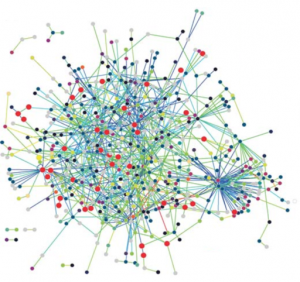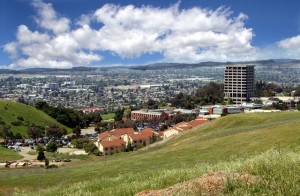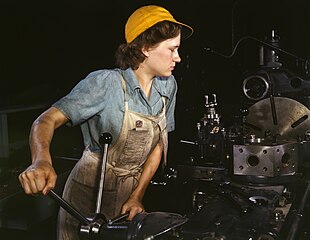 We all know that STEM retention is not a simple, linear system that can be fixed instantly with one or two modifications. A brave team of international researchers has taken on the challenge of modeling what the system of STEM retention might look like using data from first-year engineering students at a European university. You have to locate “Considering Student Retention as a Complex System: a Possible Way Forward for Enhancing Student Retention” by Forsman et al. in European Journal of Engineering Education to get the full impact of the multilayer minimum spanning tree approach they used to create the model.
One glimpse at the visualized mass of spider webs will tell you why progress in retention seems minimal and slow. The model contains about 80 elements of student life, e.g., math preparedness, study skills, quality of teaching, yet few of the elements are dominant. Many of the elements are interconnected both vertically (e.g., student, class, college) and horizontally (e.g., one student takes courses in multiple departments). The authors conclude, as many universities have already realized, that retention interventions must be made at numerous points in the university system to create impact, there is a time lag in results and assessment, and any one intervention will make a small contribution to the overall progress.
So, I’m actually trying to be encouraging here. If you have been trying to improve STEM or general retention and have seen even a slight correlation between library activities and retention, then you’re contributing to student retention and have reason to celebrate!
Image attribution: The protein interaction network of Treponema pallidum by Hauser et al. via Wikimedia Commons.
We all know that STEM retention is not a simple, linear system that can be fixed instantly with one or two modifications. A brave team of international researchers has taken on the challenge of modeling what the system of STEM retention might look like using data from first-year engineering students at a European university. You have to locate “Considering Student Retention as a Complex System: a Possible Way Forward for Enhancing Student Retention” by Forsman et al. in European Journal of Engineering Education to get the full impact of the multilayer minimum spanning tree approach they used to create the model.
One glimpse at the visualized mass of spider webs will tell you why progress in retention seems minimal and slow. The model contains about 80 elements of student life, e.g., math preparedness, study skills, quality of teaching, yet few of the elements are dominant. Many of the elements are interconnected both vertically (e.g., student, class, college) and horizontally (e.g., one student takes courses in multiple departments). The authors conclude, as many universities have already realized, that retention interventions must be made at numerous points in the university system to create impact, there is a time lag in results and assessment, and any one intervention will make a small contribution to the overall progress.
So, I’m actually trying to be encouraging here. If you have been trying to improve STEM or general retention and have seen even a slight correlation between library activities and retention, then you’re contributing to student retention and have reason to celebrate!
Image attribution: The protein interaction network of Treponema pallidum by Hauser et al. via Wikimedia Commons.  I finally found it – a publication in which a librarian is involved in a STEM retention initiative! The journal, College Teaching, published “Embedding Multiple Literacies into STEM Curricula” by Soules et al. in 2014. A team of six STEM faculty and one STEM librarian took on the daunting challenge of changing pedagogy and increasing retention at California State University, East Bay.
Their approach was to use multiple literacies to increase science learning in one upper division and three introductory STEM courses. They based activities on standards and techniques developed for K-12: Next Generation Science Standards, Common Core State Standards Initiative, and SQ3R. The librarian contributed by training students in information literacy and SQ3R, holding office hours for individual help on research papers, reviewing and commenting on draft papers, and creating online tutorials.
What were the results? Well, it was hard to tell because of all the variables. The faculty did not all use the same pedagogical tools in their courses, making comparisons between courses difficult. Although in general, the students resisted doing anything that increased the amount of time they needed to spend on a course. Within courses, the team found that students had differing responses to the reading, writing, and information activities. The team reports a learning gain of 17% in the chemistry class and 31% in the physics class, but cannot attribute the gains to their interventions, again because of numerous variables.
Disappointing . . . but still valuable. This team used teaching approaches with sound theoretical foundations that are worth trying again (which they are, by the way). Their work is a reminder that it is important to arrange something close to a control group to show the effectiveness of an intervention. And these faculty members had the foresight to involve a librarian from the beginning. Did I mention that librarian Aline Soules is the first author?
Image attribution: “Csueb view” by Jennifer Williams – originally posted to Flickr as csueb view. Licensed under CC BY-SA 2.0 via Wikimedia Commons – http://commons.wikimedia.org/wiki/File:Csueb_view.jpg#/media/File:Csueb_view.jpg
I finally found it – a publication in which a librarian is involved in a STEM retention initiative! The journal, College Teaching, published “Embedding Multiple Literacies into STEM Curricula” by Soules et al. in 2014. A team of six STEM faculty and one STEM librarian took on the daunting challenge of changing pedagogy and increasing retention at California State University, East Bay.
Their approach was to use multiple literacies to increase science learning in one upper division and three introductory STEM courses. They based activities on standards and techniques developed for K-12: Next Generation Science Standards, Common Core State Standards Initiative, and SQ3R. The librarian contributed by training students in information literacy and SQ3R, holding office hours for individual help on research papers, reviewing and commenting on draft papers, and creating online tutorials.
What were the results? Well, it was hard to tell because of all the variables. The faculty did not all use the same pedagogical tools in their courses, making comparisons between courses difficult. Although in general, the students resisted doing anything that increased the amount of time they needed to spend on a course. Within courses, the team found that students had differing responses to the reading, writing, and information activities. The team reports a learning gain of 17% in the chemistry class and 31% in the physics class, but cannot attribute the gains to their interventions, again because of numerous variables.
Disappointing . . . but still valuable. This team used teaching approaches with sound theoretical foundations that are worth trying again (which they are, by the way). Their work is a reminder that it is important to arrange something close to a control group to show the effectiveness of an intervention. And these faculty members had the foresight to involve a librarian from the beginning. Did I mention that librarian Aline Soules is the first author?
Image attribution: “Csueb view” by Jennifer Williams – originally posted to Flickr as csueb view. Licensed under CC BY-SA 2.0 via Wikimedia Commons – http://commons.wikimedia.org/wiki/File:Csueb_view.jpg#/media/File:Csueb_view.jpg
 Recently The Chronicle of Higher Education reported that under 30% of Americans are science literate. You read that right – over 70% of us are science illiterate. Half of the country thinks that humans were rubbing elbows with dinosaurs. In “Teaching Science So It Sticks,” Dan Berrett describes some of the efforts universities are making to increase science literacy among non-STEM majors to produce more knowledgeable citizens.
If you’ve ever dropped into this blog before, then the teaching methods being applied will sound familiar. The University of Oregon has changed up the names of introductory science courses, for example, “Introduction to Geology” has become “People, Rocks, & Fire.” The faculty use group-work assignments and “flipped” classrooms. Bard College offers a winter intersession course in which the students do research in a citizen science project.
Basically, faculty are making the science content more relevant and engaging for the students – that is what makes the science stick. This is exactly the kind of teaching STEM majors request when they are surveyed or interviewed about the difficulties of completing a science major. Even though they are talented in science, they still need the social context and applications of science to stay motivated in their studies and eventual careers. STEM retention initiatives focusing on pedagogy could learn a lot from these “lowly” science literacy initiatives.
Image: Attributed to John Scalzi, “The Image You’ve Slogged through the Whole Set to See,” 2007. Some rights reserved.
Recently The Chronicle of Higher Education reported that under 30% of Americans are science literate. You read that right – over 70% of us are science illiterate. Half of the country thinks that humans were rubbing elbows with dinosaurs. In “Teaching Science So It Sticks,” Dan Berrett describes some of the efforts universities are making to increase science literacy among non-STEM majors to produce more knowledgeable citizens.
If you’ve ever dropped into this blog before, then the teaching methods being applied will sound familiar. The University of Oregon has changed up the names of introductory science courses, for example, “Introduction to Geology” has become “People, Rocks, & Fire.” The faculty use group-work assignments and “flipped” classrooms. Bard College offers a winter intersession course in which the students do research in a citizen science project.
Basically, faculty are making the science content more relevant and engaging for the students – that is what makes the science stick. This is exactly the kind of teaching STEM majors request when they are surveyed or interviewed about the difficulties of completing a science major. Even though they are talented in science, they still need the social context and applications of science to stay motivated in their studies and eventual careers. STEM retention initiatives focusing on pedagogy could learn a lot from these “lowly” science literacy initiatives.
Image: Attributed to John Scalzi, “The Image You’ve Slogged through the Whole Set to See,” 2007. Some rights reserved.
 Guest blogger: Laura Palumbo
Chemistry & Physics Librarian/Science Data Specialist
Rutgers University, New Brunswick, NJ
laura.palumbo@rutgers.edu
@LauraBPalumbo
________________
The recent post in this blog on the lack of self-efficacy of women in STEM reflects the findings of much of the current literature: that women tend to underestimate their abilities in math and related STEM fields. Encouragement from parents, teachers, and faculty can help change this self-perception. In a 2014 Google white paper, Women Who Choose Computer Science- What Really Matters, research showed “. . . that encouragement and exposure are key controllable indicators for whether or not young women decide to pursue a Computer Science degree” (p. 2). With facts like these in mind, this past Fall I opted to teach a one-credit seminar for freshmen, along with our engineering librarian, titled “Closing the Gap: Women in Science, Technology, Engineering and Math.”
These seminars, named Byrne Seminars after the family who donated the funds to create them in 2007, allow new students at Rutgers to explore a variety of fields of research, taught by tenured or tenure-track faculty who are passionate about their subjects. For our seminar, we decided that our goals would be to enable students to explore career opportunities in STEM; learn about past and present contributions of women in STEM; understand the various reasons for the existence of the ongoing gender gap in STEM; and as a final project, create Wikipedia entries for women in STEM. Fifteen enthusiastic students completed our first seminar.
The lack of representation of women in Wikipedia was noticed by feminists such as Adrienne Wadewitz, who began encouraging women to edit Wikipedia. By having our students become editors and creators of entries for women in STEM, we have raised awareness of this issue, and provided a small measure of correction. Of course, being librarians we didn’t neglect the opportunities for information literacy instruction during this exercise! Several good resources for teaching with Wikipedia exist through the Wikimedia Foundation, as well as articles by librarians who are using Wikipedia to teach information literacy.
In addition to this project, we had students review and discuss the literature around the gender gap in STEM fields. Concurrent with this, we arranged for our students to visit the labs of two of our female scientists at Rutgers, and brought in women who are working in STEM industries as guest speakers. By exploring the literature around the persistent gender gap in STEM, and by combining this with exposure to successful women scientists, we are providing encouragement which we hope will lead to improved self-efficacy for a new class of future STEM leaders.
__________________________
Thanks to Laura for sharing her inspiring work on STEM retention. If anyone else has an idea, service, or program to share, I’d be happy to post it on Science Retention Librarian. Contact me at erin.otoole@unt.edu.
Erin
Guest blogger: Laura Palumbo
Chemistry & Physics Librarian/Science Data Specialist
Rutgers University, New Brunswick, NJ
laura.palumbo@rutgers.edu
@LauraBPalumbo
________________
The recent post in this blog on the lack of self-efficacy of women in STEM reflects the findings of much of the current literature: that women tend to underestimate their abilities in math and related STEM fields. Encouragement from parents, teachers, and faculty can help change this self-perception. In a 2014 Google white paper, Women Who Choose Computer Science- What Really Matters, research showed “. . . that encouragement and exposure are key controllable indicators for whether or not young women decide to pursue a Computer Science degree” (p. 2). With facts like these in mind, this past Fall I opted to teach a one-credit seminar for freshmen, along with our engineering librarian, titled “Closing the Gap: Women in Science, Technology, Engineering and Math.”
These seminars, named Byrne Seminars after the family who donated the funds to create them in 2007, allow new students at Rutgers to explore a variety of fields of research, taught by tenured or tenure-track faculty who are passionate about their subjects. For our seminar, we decided that our goals would be to enable students to explore career opportunities in STEM; learn about past and present contributions of women in STEM; understand the various reasons for the existence of the ongoing gender gap in STEM; and as a final project, create Wikipedia entries for women in STEM. Fifteen enthusiastic students completed our first seminar.
The lack of representation of women in Wikipedia was noticed by feminists such as Adrienne Wadewitz, who began encouraging women to edit Wikipedia. By having our students become editors and creators of entries for women in STEM, we have raised awareness of this issue, and provided a small measure of correction. Of course, being librarians we didn’t neglect the opportunities for information literacy instruction during this exercise! Several good resources for teaching with Wikipedia exist through the Wikimedia Foundation, as well as articles by librarians who are using Wikipedia to teach information literacy.
In addition to this project, we had students review and discuss the literature around the gender gap in STEM fields. Concurrent with this, we arranged for our students to visit the labs of two of our female scientists at Rutgers, and brought in women who are working in STEM industries as guest speakers. By exploring the literature around the persistent gender gap in STEM, and by combining this with exposure to successful women scientists, we are providing encouragement which we hope will lead to improved self-efficacy for a new class of future STEM leaders.
__________________________
Thanks to Laura for sharing her inspiring work on STEM retention. If anyone else has an idea, service, or program to share, I’d be happy to post it on Science Retention Librarian. Contact me at erin.otoole@unt.edu.
Erin

Turret lathe operator machining parts for transport planes at the Consolidated Aircraft Corporation plant, Fort Worth, Texas, USA, 1942


